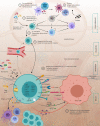Tissue-resident memory T cells in tumor immunity and immunotherapy
- PMID: 33755718
- PMCID: PMC7992502
- DOI: 10.1084/jem.20201605
Tissue-resident memory T cells in tumor immunity and immunotherapy
Abstract
Tissue-resident memory T cells (TRM) represent a heterogeneous T cell population with the functionality of both effector and memory T cells. TRM express residence gene signatures. This feature allows them to traffic to, reside in, and potentially patrol peripheral tissues, thereby enforcing an efficient long-term immune-protective role. Recent studies have revealed TRM involvement in tumor immune responses. TRM tumor infiltration correlates with enhanced response to current immunotherapy and is often associated with favorable clinical outcome in patients with cancer. Thus, targeting TRM may lead to enhanced cancer immunotherapy efficacy. Here, we review and discuss recent advances on the nature of TRM in the context of tumor immunity and immunotherapy.
© 2021 Okła et al.
Conflict of interest statement
Disclosures: The authors declare no competing interests exist.
Figures


References
Publication types
MeSH terms
Grants and funding
LinkOut - more resources
Full Text Sources
Other Literature Sources
Medical

